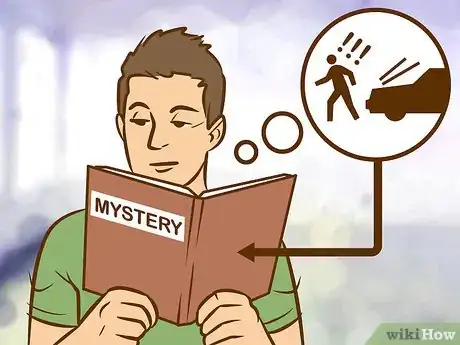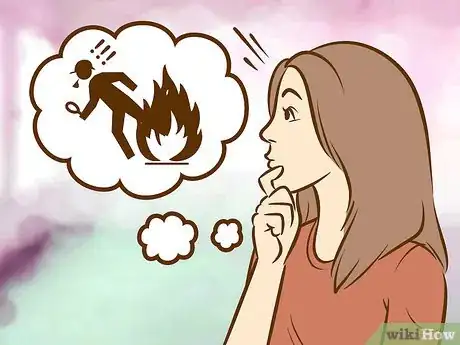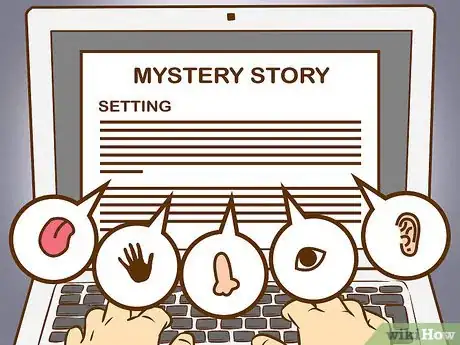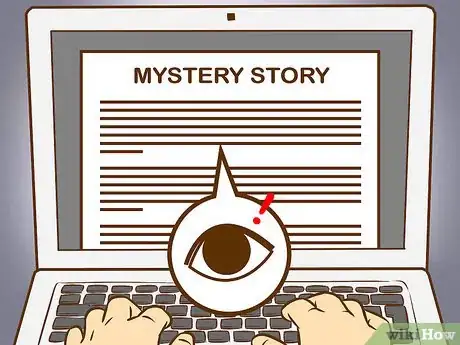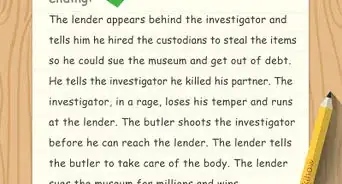This article was co-authored by Lucy V. Hay. Lucy V. Hay is an author, script editor and blogger who helps other writers through writing workshops, courses, and her blog Bang2Write. Lucy is the producer of two British thrillers and her debut crime novel, The Other Twin, is currently being adapted for the screen by Free@Last TV, makers of the Emmy-nominated Agatha Raisin.
There are 10 references cited in this article, which can be found at the bottom of the page.
This article has been viewed 545,937 times.
A good mystery story will have fascinating characters, exciting suspense, and a puzzle that keeps you turning the pages. But it can be difficult to write an engaging mystery story, especially if you have never tried to before. With the right preparation, brainstorming, and outlining, you can create a page-turning mystery of your own.
Steps
Preparing to Write
-
1Understand the distinction between the mystery genre and the thriller genre. Mysteries almost always begin with some sort of crime or question that someone has to answer. The major question in a mystery is who committed the crime. Thrillers usually begin with a situation that leads to a major catastrophe, like an assassination, a bank robbery, a nuclear explosion, etc. The major question in a thriller is whether or not the hero can prevent the catastrophe from occurring.
- When it comes to mystery, one of the key elements is tension and making the story compelling from the very beginning.[1]
- In mystery stories, your reader does not know who committed the murder until the end of the novel. Mysteries are centered on the intellectual exercise of trying to figure out the motivations behind the crime, or the puzzle.
- Mysteries tend to be written in the first person, while thrillers are often written in the third person and from multiple points of view. In mystery stories, there is usually a slower pace as the hero/detective/main character tries to solve the crime. There are also limited action sequences in mysteries than in thrillers.
- Because mysteries are often slower paced, the characters are usually more in-depth and well rounded in a mystery story than in a thriller.
-
2Read examples of mystery stories. There are many great mystery stories that you can read to get a sense of a well-plotted, well-developed mystery.[2]
- The Woman in White by Wilkie Collins. The 19th-century mystery novel was originally written in serial form, so the story moves forward in measured steps. Much of what became standard in crime fiction was done by Collins in this novel, so it is an engaging and instructive introduction to the genre.
- The Big Sleep by Raymond Chandler. Chandler is one of the genre’s greatest writers, creating engaging stories about the trials and tribulations of private detective Philip Marlowe. Marlowe is a tough, cynical, but honest P.I. who becomes entangled in a plot with a General, his daughter, and a blackmailing photographer. Chandler’s work is known for its sharp dialogue, great pacing, and riveting hero, Marlowe.[3]
- The Adventures of Sherlock Holmes by Sir Arthur Conan Doyle. One of the genre’s most famous detectives, along with his equally famous sleuthing partner Watson, solves a series of mysteries and crimes in this collection of stories. Holmes and Watson inject their unique character traits into the stories along the way.[4]
- NANCY DREW by Carolyn Keene. The whole series is situated in the United States.Nancy Drew is a detective. Her close friends Helen Corning, Bess Marvin and George Fayne appear in some mysteries. Nancy is Carson Drew's daughter. Carson Drew is the most famous lawyer in River Heights, where they live.
- "Hardy Boys by Franklin W. Dixon.This is similar to Nancy Drew.It is about two brothers: Frank and Joe Hardy, who are talented detectives.They are the sons of a very famous detective, and they sometimes help in his cases.
- A Crime in the Neighborhood by Suzanne Berne. This recent mystery novel is set in 1970s suburban Washington. It centers on the “crime” in the neighborhood, the murder of a young boy. Berne intersperses a coming of age story with the mystery of the death of the young boy in bland, boring suburbia, but manages to make the story anything but bland or boring.[5]
Advertisement -
3Identify the main character in an example story. Think about how the author introduces the main character and how the author describes the main character.
- For example, in The Big Sleep, Chandler’s first-person narrator describes himself through his clothing on the first page: “I was wearing my powder-blue suit, with the dark blue shirt, tie and display handkerchief, black brogues, black wool socks with dark blue clocks on them. I was neat, clean, shaved and sober, and I didn’t care who knew it. I was everything the well-dressed private detective ought to be."
- With these opening sentences, Chandler makes the narrator distinct through his way of describing himself, his outfit, and his job (private detective).
-
4Note the setting or time period of an example story. Think about how the author situates the story in the setting or time period.
- For example, in the second paragraph of the first page of The Big Sleep, Marlowe places the reader in the time and setting: “The main hallway of the Sternwood place was two stories high.”
- The reader now knows Marlowe is in front of the home of the Sternwoods and it is a larger home, possibly wealthy.
-
5Consider the crime or mystery the main character needs to solve. What is the crime that the main character has to solve or deal with in some way? This could be a murder, a missing person, or a suspicious suicide.
- In The Big Sleep, Marlowe is hired by General Sternwood to “take care” of a photographer who has been blackmailing the General with scandalous pictures of the General’s daughter.
-
6Identify the obstacles or problems the main character encounters. A good mystery will keep readers hooked by complicating the main character’s mission (to solve the crime) with obstacles or problems.
- In The Big Sleep, Chandler complicates Marlowe’s pursuit of the photographer by having the photographer killed in the early chapters, followed by the suspicious suicide of the General’s chauffeur. So Chandler sets up the story with two crimes that Marlowe has to solve.
-
7Note the resolution of the mystery. Think about how the mystery is resolved at the end of the story. The solution to the mystery should not feel too obvious or forced, but it also should not seem too out of left field or implausible.
- The resolution of the mystery should feel surprising to your reader, without confusing them. One of the benefits of a mystery is that you can pace the story so the solution unfolds gradually, rather than in a rushed or hurried manner.
Developing Your Main Character and Outlining the Story
-
1Create your detective or sleuth. Your main character can also be a private citizen or innocent bystander to a crime who gets drawn into solving the mystery. Brainstorm specific details of your main character, including:[6]
- Body size and shape, hair and eye color, and any other physical characteristics. For example, you may have a short female main character with dark hair, glasses, and green eyes. Or you may want a more typical detective character: tall with slicked-back hair and a five o’clock shadow.
- Clothing and dress. Your character’s clothing will not only create a more detailed image for your reader, it can also indicate what time period your story is set in. For example, if your main character wears heavy armor and a helmet with a crest, your reader will realize your story is set in medieval times. If your character wears a hoodie, jeans, and a backpack, this will tip off your readers that the story is likely set in modern times.
- What makes your main character unique. It’s important to create a main character who stands out to your reader and feels engaging enough to sustain many pages in a story or novel. Consider what your character likes and dislikes. Maybe your female sleuth is shy and awkward at parties, and has a secret love of reptiles. Or perhaps your detective is a complete klutz and doesn’t consider himself a strong or smart person. Focus on details that will help to create a unique main character and don’t be afraid to draw on details from your own life or your own preferences and tastes.[7]
- What matters most is that your main character has a burning question or burning need to solve the mystery.
-
2Determine the setting. Place the story in a setting you know well, like your hometown or your school. Or do some research on a setting you are unfamiliar with, like 70s California or 40s Britain. If you use a setting you have not experienced first hand, focus on specific settings, like a suburban home in 70s California or a boarding house in 40s Britain.
- If you decide to set your story in a time period or location you are unfamiliar with, conduct research on the time period or location through your local library, online sources, or interviews with experts in a certain time period or location. Be specific with your research and during your interviews to ensure you get all the details of a setting or time period right.
-
3Create the puzzle or mystery. Not all mysteries need to have a murder or major crime. But the bigger the crime, usually the higher the stakes in the story will be. High stakes are important because they engage your reader and give him or her a reason to keep reading. Possible sources for mystery could be:
- An item is stolen from your main character or someone close to the main character.
- A person close to the main character disappears.
- The main character receives threatening or disturbing notes.
- The main character witnesses a crime.
- The main character is asked to help solve a crime.
- The main character stumbles upon a mystery.
- You can also combine several of these scenarios to create a more layered mystery. For example, an item may be stolen from your main character, a person close to the main character disappears, and then the main character witnesses a crime she is later asked to help solve.
-
4Decide how you are going to complicate the puzzle or mystery. Build up tension in the story by making it difficult for your main character to solve the puzzle or mystery. You can use obstacles like other people, or suspects, false leads, misleading clues, or another crime.
- Create a list of possible suspects your main character may encounter throughout the story. You can use several suspects to point the detective and/or the reader in the wrong direction to build suspense and surprise.[8]
- Write a list of clues. Red herrings are clues that are false or misleading. Your story will be stronger if you include several red herring clues in the story. For example, your main character may find a clue that points to one suspect, but it is later revealed the clue is actually tied to a different suspect. Or your detective may find a clue without realizing it is the key to unlocking the entire mystery.[9]
- Red herrings are all about saying "follow this thread" when the "thread" in question is completely wrong. A good writer can put something in the way that stops readers from realizing what's going on.
-
5Use cliffhangers to keep the story entertaining. A cliffhanger is a moment, usually at the end of a scene, where the main character is in a situation that traps them or places them in danger. Cliffhangers are important in a mystery because they keep your reader engaged and propels the story forward. Possible cliffhangers could be:
- The main character is investigating a possible lead alone and encounters the murderer or killer.
- The main character begins to doubt his/her abilities and lets his/her guard down, allowing the murderer to kill again.
- No one believes the main character and he/she ends up trying to solve the crime alone,and he/she ends up getting kidnapped.
- The main character is injured and trapped in a dangerous place.
- The main character is going to lose an important clue if he/she can’t get out of a certain location or situation.
-
6Create a resolution or ending. Wrap up the story with the solution to the puzzle. At the end of most mysteries, the main character has a positive change or shift in his/her perspective. Possible resolutions include:
- The main character saves someone close to them, or an innocent person wrapped up in the mystery.
- The main character saves himself/herself and is changed by his/her courage or smarts.
- The main character exposes a bad character or organization.
- The main character exposes the murderer or person responsible for the crime.
-
7Write a story outline. Now that you have considered all the aspects of your story, create a clear outline of the plot. It’s important to map out how exactly the mystery will unfold before you sit down to write the story, as this will ensure there will are no loose ends in the mystery. Your outline should be in the order the events or plot points are going to occur in the story. It should include:[10]
- Introduction of main character and setting.
- The inciting incident, or the crime.
- The call to adventure: The main character gets involved in solving the crime.
- Tests and trials: The main character finds clues, encounters potential suspects, and tries to stay alive as he/she pursues the truth. Close ones might be kidnapped as a threat
- Ordeal: The main character thinks he/she has found a key clue or suspect and believes he/she has solved the crime. This is a false resolution, and is a good way to surprise your reader when it turns out the main character got it wrong.
- Major setback: All seems lost for the main character. He/She found the wrong suspect or clue, someone else is killed or harmed, and all his/her allies have abandoned him/her. A major setback will amp up the tension in the story and keep the reader guessing.
- The reveal: The main character gathers all interested parties together, lays out the clues, explains the false leads, and reveals who the murderer or guilty person is.
Writing the Story
-
1Use the five senses to describe the setting. One of the best ways to create a setting or atmosphere is to focus on the five senses: sight, sound, smell, touch, and taste. Descriptions of sensory details can also create backstory for your character. For example, rather than tell the reader your character had cereal for breakfast, you can have the character taste the remnants of cereal on his/her tongue. Or she can smell the cereal she spilled on his/her hands.
- Think what your main character might see in a certain setting. For example, if your character lives in a home much like yours in a small town, you may describe his/her bedroom or his/her walk to school. If you are using a specific historical setting, like 70s California, you may describe your character standing on a street corner and looking at the unique architecture or the cars that drive by.
- Consider what your main character might hear in a certain setting. Your sleuth may listen to the birds chirping and the sprinklers on the lawns on the way to school. Or your detective may hear the roaring of cars or the crashing of ocean waves.
- Describe what your main character might smell in a certain setting. Your main character might wake up to the smell of coffee being made in the kitchen by his/her parents. Or your detective may be hit with the smell of the city: rotting garbage and body odor.
- Describe what your character might feel. This could be a light breeze, a sharp pain, a sudden jolt, or a shiver down his/her spine. Focus on how your character’s body might react to a feeling.
- Think about what your character might taste. Your main character may still taste the cereal she had for breakfast in his/her mouth, or the drink from the night before.
-
2Start the action right away. Skip long paragraphs of description of setting or character, especially in the early pages. You want to hook your reader by starting right in the action, as your main character is moving and thinking.[11]
- Think about being concise with your language and description. Most readers continue reading a good mystery because they are invested in the main character and want to see his/her succeed. Be brief but specific when describing the main character and his/her perspective on the world.
- For example, Chandler’s The Big Sleep starts by situating the reader in a setting and gives the reader a sense of the main character’s perspective on the world. “It was about eleven o’clock in the morning, mid October, with the sun not shining and a look of hard wet rain in the clearness of the foothills. I was wearing my powder-blue suit, with dark blue shirt, tie and display handkerchief, black brogues, black wool socks with dark blue clocks on them. I was neat, clean, shaved and sober, and I didn’t care who knew it. I was everything the well-dressed private detective ought to be. I was calling on four million dollars.”
- With this beginning, the story starts in action, with a specific time, date, and description of the setting. It then presents the main character’s physical description and job title. The section ends with the main character’s motivation: four million dollars. In three lines, Chandler has covered many of the essential details of the character, the setting, and the story.
-
3Show, don’t tell. If you tell your reader, “the detective was cool”, the reader will have to take your word for it. But if you show your reader the detective was cool by describing the clothing she wears and the way she walks into a room, the reader can see how cool the character is. The impact of showing your reader certain details is much more powerful than simply telling the reader what to think.[12]
- Think about how you would react in a situation if you were angry or scared. Have your character react in ways that communicate angry or scared, without telling the reader about the character’s emotions. For example, rather than “Stephanie was angry,” you could write: “Stephanie slammed his/her water glass down on the table so hard his/her dinner plate rattled. She glared at him, and started ripping the thin, white napkin into shreds with his/her fingers.”
- Showing, rather than telling also works well for descriptions of setting. For example, in The Big Sleep, rather than tell the reader the Sternwoods were wealthy, Chandler describes the luxurious details of the estate: “There were French doors at the back of the hall, beyond them a wide sweep of emerald grass to a white garage, in front of which a slim dark young chauffeur in shiny black leggings was dusting a maroon Packard convertible. Beyond the garage were some decorative trees trimmed as carefully as poodle dogs. Beyond them a large greenhouse with a domed roof. Then more trees and beyond everything the solid, uneven, comfortable line of the foothills.”
-
4Surprise your reader but don’t confuse her. When creating a mystery, it’s important that the resolution does not feel abrupt or cheap. Try to always play fair and aim to surprise, rather than confuse, your reader. The clues presented in the story should lead to the solution in a logical and clear way, despite any red herrings or false leads. Your reader will enjoy the ending if you make him/her think, “It’s so obvious, I should have known!”[13]
-
5Revise your first draft. Once you have created a first draft of your mystery story, go through your pages and look for key aspects, including:[14]
- Plot. Ensure your story sticks to the outline and has a clear beginning, middle, and an ending. You should also confirm your main character shifts or changes at the end of the story.
- Characters. Are your characters, including your main character, distinct and unique? Do all the characters sound and act the same or are they different from each other? Do your characters feel original and engaging?
- Pacing. Pacing is how fast or how slow the action moves in the story. Good pacing will feel invisible to the reader. If the story feels like it is moving too fast, make the scenes longer to draw out the emotions of the characters. If it feels like the story gets bogged down or confusing, shorten the scenes to only include essential information. A good rule of thumb is to always end a scene earlier than you might think or want. This will keep the tension from scene to scene from dropping and keep the pace of the story moving.
- The twist. The twist can either make or break a good mystery story. This is completely optional, but many of the best stories have a twist at the end. Make sure that a twist is not too "cheesy". The more unique a twist is, the easier it is to write. When writing an overused twist, such as "then they woke up", you'll need to be a very good writer to make it sound good. A good twist not only fools the audience, but fools the character(s) too. Consider hinting towards the twist during action scenes, so that when the reader looks back on the story, they'll wonder how they missed it. Try not to make the twist evident too early on.
Mystery Story Help
Community Q&A
-
QuestionI want to write a mystery story for creative writing, but I am a kid. Can you give me easy instructions?
 Community AnswerFirst use suspense at the start, usually in the form of a crime. Secondly, start adding clues for the investigator or main character, and introduce one or more suspects. Finally, the main character either solves the mystery, or doesn't, if you want to end on a cliffhanger and write a second part to your story.
Community AnswerFirst use suspense at the start, usually in the form of a crime. Secondly, start adding clues for the investigator or main character, and introduce one or more suspects. Finally, the main character either solves the mystery, or doesn't, if you want to end on a cliffhanger and write a second part to your story. -
QuestionHow can I write a very small mystery story for an exam?
 Community AnswerIf you are taking creative writing classes in college or high school or anything like that, make sure you pay close attention to the aspects of making a good character and a great story plot. I am taking a creative writing course myself, and I have started out my writing response by making a good villain. One of the main keys to making a good villain (or any kind of character, really) is to make sure they have a desire, something they want. If you have that, then you can build off of that and develop your story even more.
Community AnswerIf you are taking creative writing classes in college or high school or anything like that, make sure you pay close attention to the aspects of making a good character and a great story plot. I am taking a creative writing course myself, and I have started out my writing response by making a good villain. One of the main keys to making a good villain (or any kind of character, really) is to make sure they have a desire, something they want. If you have that, then you can build off of that and develop your story even more. -
QuestionHow do I write the title of the story?
 Community AnswerThe title of the story can often be the last thing you write, or come close to the end of the writing process. It can be hard to come up with a title if you don't know your story very well , so writing your story can often provide insight on good titles. The book could be named after a character, a key theme or item in the book, or even a place name. If you're planning on writing a series of books, it could be an idea to involve the main character's name in the title.
Community AnswerThe title of the story can often be the last thing you write, or come close to the end of the writing process. It can be hard to come up with a title if you don't know your story very well , so writing your story can often provide insight on good titles. The book could be named after a character, a key theme or item in the book, or even a place name. If you're planning on writing a series of books, it could be an idea to involve the main character's name in the title.
Things You'll Need
- Paper and pen and/or a computer with a word processor (like Word)
- Mystery books/stories
- An idea/plot for the story
- Thesaurus
References
- ↑ https://www.writersdigest.com/write-better-fiction/7-tips-writing-great-mystery-suspense-novels
- ↑ http://www.publishersweekly.com/pw/by-topic/industry-news/tip-sheet/article/59582-the-10-best-mystery-books.html
- ↑ http://www.sparknotes.com/lit/bigsleep/summary.html
- ↑ http://www.gutenberg.org/files/1661/1661-h/1661-h.htm
- ↑ https://www.nytimes.com/books/97/07/20/reviews/970720.20careyt.html
- ↑ http://blog.karenwoodward.org/2013/10/how-to-write-murder-mystery.html
- ↑ http://blog.karenwoodward.org/2013/10/how-to-write-murder-mystery.html
- ↑ http://www.creative-writing-now.com/how-to-write-a-mystery.html
- ↑ http://www.creative-writing-now.com/how-to-write-a-mystery.html
- ↑ http://blog.karenwoodward.org/2014/03/how-to-write-murderously-good-mystery.html
- ↑ http://www.creative-writing-now.com/how-to-write-a-mystery.html
- ↑ http://www.creative-writing-now.com/how-to-write-fiction.html
- ↑ http://www.creative-writing-now.com/how-to-write-a-mystery.html
- ↑ http://blog.karenwoodward.org/2013/10/how-to-write-murder-mystery-part-two.html
About This Article
Before you write your mystery story you’ll want to create some characters and outline the plot. You might make your main character a detective or just a curious citizen who witnessed a crime. Once you have characters, choose a setting and a mystery such as a murder or a robbery of a precious artwork. If you want to make your story dramatic, add in cliffhangers and red herrings, or clues that lead to dead ends. When you’re ready to write your story, scroll down for tips from our Creative Writing reviewer on creating a well-paced and exciting narrative.





